
Let me tell you about an experience that marked my tragic descent into otaku-dom:
The year was 1996 and six teenage anime fans, three male, three female, were on a kind-of, sort-of triple date. The six of us gathered at the home with the least parental supervision to do what unattended teenagers do when their parents aren’t around: watch a truckload of anime. It was a kind-of, sort-of anime date, the type of adolescent nerdery that no self-respecting person would brag about in a column that could be read by the entire Internet.
So what did we decide to watch on Anime Date Night in this den of burgeoning non-romance? Fourth generation fansubs of Fushigi Yuugi? Marmalade Boy? Sailor Moon? Any of a number of anime shows, available through means legal or otherwise, that were known to appeal to young anime fans of the female persuasion?
Hell no.
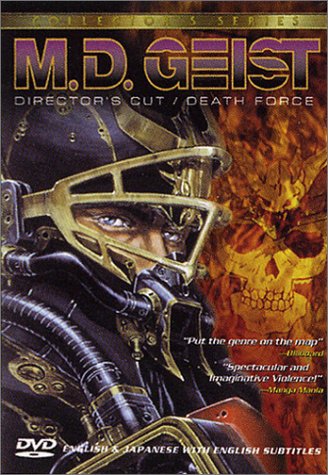 Instead, my male colleagues and I stormed the local Blockbuster Video. We marched home with rented VHS copies of M.D. Geist, M.D. Geist II: Death Force, and—just for variety—a lovely little OVA known as Baoh.
Instead, my male colleagues and I stormed the local Blockbuster Video. We marched home with rented VHS copies of M.D. Geist, M.D. Geist II: Death Force, and—just for variety—a lovely little OVA known as Baoh.
I’d be lying if I said that only the boys enjoyed Anime Date Night. At least one of the girls was cackling along with us. We hooted at every gratuitous beheading. We jeered at every animated disembowelment. We cheered at every explosion. The four of us mocked the English dubbing ferociously while the other two young ladies crouched like gargoyles on the far side of the couch with expressions of mild horror and disgust painted on their stony faces.
There was no sequel to Anime Date Night.
The above story, although embellished perhaps by the diaphanous veil of memory, is absolutely true. It was also the last time I had seen M.D. Geist for the better part of two decades. But I didn’t need to re-watch M.D. Geist during those intervening years, because I carried the memory of its absurdity with me like a set of battle scars. The awesome and awful fact of M.D. Geist‘s existence lingered, ever-present but invisible, like the specters of urban legend that be summoned in a dark room with a mirror and an incantation. Years later whenever I gathered among fellow otaku and the topic strayed to anime that was terrible, invariably someone would bring up M.D. Geist and we’d all smile and nod in agreement.
So what is M.D. Geist, and is it as bad as everyone claims it to be?
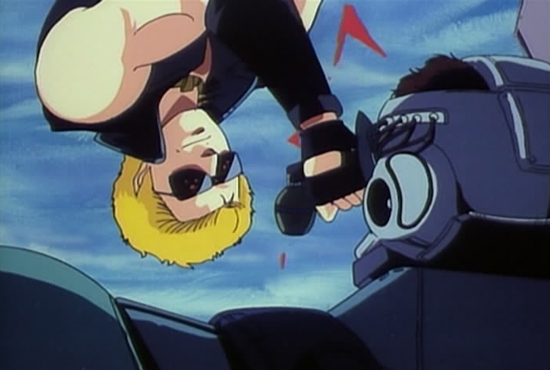
Here’s the scoop: it’s the future and there’s this colony world called Jerra, and some huge military faction is at war with some other huge military faction. Before the war grinds to a stalemate, bold new developments in wholesale slaughter are introduced, most notably the Fightech powered armor and genetically modified super-soldiers. One such soldier is the titular M.D. (“Most Dangerous”) Geist, who is apparently such an unstoppable bad-ass that his creators imprisoned him in suspended animation on a satellite shaped like an hourglass. The hourglass satellite crashes and Geist is once again free to engage in the glorious combat he so desperately craves. At least, I think that’s what’s going on here. M.D. Geist is light on exposition and Koichi Ohata is not the sort of animator who offers to apologize or to explain.
After gaining his freedom, Geist steals a set of Fightech armor from a pin-cushioned corpse and murders (in hilarious fashion) the leader of a post-apocalyptic biker gang, thus becoming the new gang leader. Geist also rejects the advances of requisite bad-girl biker lady Vaiya, because Geist is a super-soldier, and super-soldiers love only war and overly elaborate skull displays. Flash forward a bit and Geist and his bikers save an armored transport full of regular army soldiers from certain destruction at the hands of their enemies. Then the regular army enlists Geist’s aid to storm the Brain Palace in order to deactivate the Death Force, a legion of robotic killing machines designed to eradicate humanity from the face of Jerra. In a twist ending that surprises literally no one, Geist betrays the regular army and activates the Death Force instead. Who would have thought that a complete psychopath with no regard for anyone other than himself and no love for anything but constant, endless war would do such a thing? I’m shocked. Shocked!
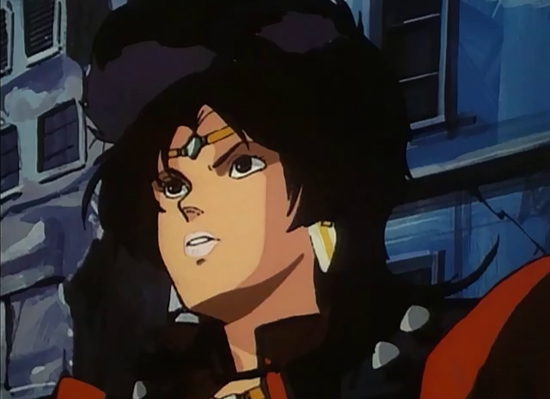
The above describes the Director’s Cut of M.D. Geist, which was produced in conjunction with the sequel, Death Force, in 1996. Ohata and company animated new sequences and redubbed the audio with a new voice cast for the Director’s Cut, attempting to smooth out the jagged edges of the earlier 1986 version by filling in Geist’s back-story and providing more context for the war on Jerra. I actually prefer the original 1986 VHS version. It concludes on a wildly nihilistic note, with Vaiya screaming in terror as Geist flips the switch that ends the world. It also leaves the horrors of the Death Force purely up to the imagination of the audience, and that’s invariably more unsettling than the giant centaur robots and murderous cybernetic trilobites that we see in the sequel. The original cut of M.D. Geist is 200-proof, pure, unadulterated lunacy, and I love it. I wish that the original 1986 version was still readily available.
As improbable as M.D. Geist is, the existence of the sequel, M.D. Geist II: Death Force, is even more ridiculous. Co-produced by John O’Donell, the head honcho of the late, lamented Central Park Media, Death Force was created a decade after the release of the first OVA. Death Force is an older and more experienced Ohata attempting to tell a more straightforward story. I say “attempting” because if anything Death Force is more ludicrous than its predecessor.
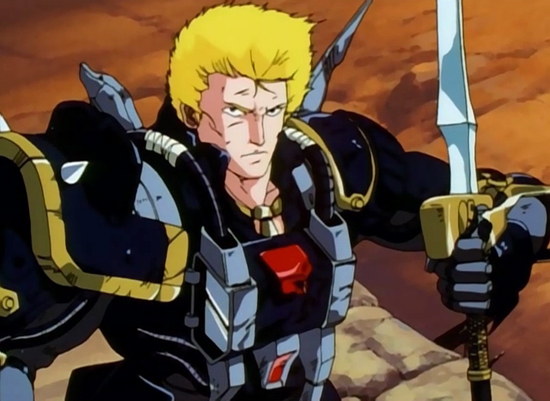
In the sequel, Geist plays the role of the boogieman while M.D. Krauser, the prototype of the super-soldier project, plays the role of the savior of humanity. While Geist is content to hunt robots while using people as live bait, Krauser tries to rebuild civilization from the ruins, but Krauser’s delusions of grandeur ultimately spell the undoing of his futuristic fiefdom. Vaiya also returns to get more naked more often than in the first OVA. There’s intrigue as the remnants of the regular army conspire to eliminate Krauser along with the Death Force. There are jet-pack battles and the requisite gigantic Akira-inspired explosions and more gruesome, gory death scenes than you can shake a stick at. Much like its predecessor, Death Force is big and loud and dumb and in the end pretty much everybody dies. The first M.D. Geist production reminds me of a hyper-energetic kid doing a ‘cannonball’ off the diving board at the public pool: graceless, but at least it makes an enormous splash. Death Force is like that same kid ten years later ascending to the highest diving platform, posing like an Olympian, leaping, twirling, and hitting the water with a tremendous ‘belly-flop’. Ohata and company tried to restrain the excesses that made M.D. Geist the fabulous beast that it is, only to produce something just as goofy as the original.
I own the 2002 DVD release of M.D. Geist from Central Park Media. This is a surprisingly plush 2-disc release which features a commentary track by director Koichi Ohata and screenwriter Riku Sanjo. The commentary track is enlightening. Recorded 16 years after the release of the first OVA, Ohata and Sanjo freely admit the influence of violent Western movies (Mad Max, The Terminator, Alien) and Japanese pro-wrestling as sources of inspiration for M.D. Geist. Ohata muses about how Geist is a reaction to the sort of angsty, troubled teenager characters exemplified by Amuro Ray of Mobile Suit Gundam. Ohata admits to terrorizing his animators with his ornate mechanical designs and to terrorizing the studio’s cat with a vacuum cleaner. He expounds on his love of horror movies and his gleeful fascination with finding new and gruesome ways to murder people onscreen. Most significantly, both Ohata and Sanjo admit that their youthful exuberance while creating M.D. Geist often out-paced their ability to tell a coherent story. They profess that even they sometimes have trouble following what’s going on, and that degree of candor is refreshing.
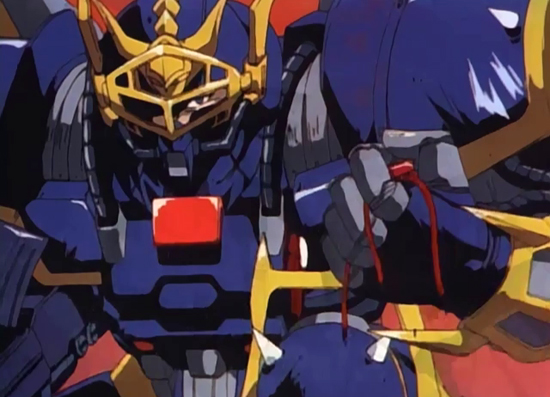
In 2009, ADV Films rescued the M.D. Geist license from obscurity, but this version appears to be out-of-print. Additionally, the ADV release lacks any sort of commentary track, so if you acquire this version you will only be able to experience M.D. Geist in its raw, primal state. I had almost forgotten about the ADV release until I stumbled across it and another copy of the Central Park Media release while shifting through some storage bins. Yes, I own two spare DVD copies of M.D. Geist and M.D. Geist II: Death Force. No, you can’t have one. I need that double-redundancy, in case the world ends, and we all get eaten by robots, and only the perfectly preserved, still shrink-wrapped copies in my collection survive to tell the story of an anime that is as shameless as it is stupid and of a time period when pure adolescent, lizard-brained, id-appealing entertainment was the rule.
Whether I’m proud to admit it or not, Koichi Ohata is partially responsible for what I perceive anime to be. In the formative years of my fandom, productions like M.D. Geist and Genocyber taught me that anime can be raw and rough and brimming with manic energy. Anime can be a whole lot of guts and very little brains, with plenty of both spilled across the celluloid in vibrant Technicolor. When I think of the nigh-extinct original video animation market, I think of the qualities embodied by M.D. Geist: anime that is over-sexed, ultra-violent, and anti-social. I think of narrative incoherence. I think of the overly-elaborate mechanical foot of Style crushing Substance’s lovingly rendered skull. I think of storylines and plot threads that careen gloriously into oblivion. M.D. Geist may be a tale told by an idiot, full of sound and fury, signifying nothing, but what a fabulous nothing it is!
Distributor: Central Park Media
Originally Released: 1986
Running Time: 93 minutes
Related Stories:
– The Truth About M.D. Geist
– [Anime Classics] Baoh
– Central Park Media: More “Quality” than Pirsig
– Slayers: A Retrospective
– Kamen Rider x Kamen Rider Fourze & Wizard: Ultimatum


![SSSS.Dynazenon [Anime Review] SSSS.Dynazenon [Anime Review]](https://otakuusamagazine.com/wp-content/uploads/2021/08/16-9-SSSS.Dynazenon_Key_Visual_3.5-480x360.jpg)
![Back Arrow [Anime Review] Back Arrow [Anime Review]](https://otakuusamagazine.com/wp-content/uploads/2021/07/ba15-02686-480x360.jpg)



